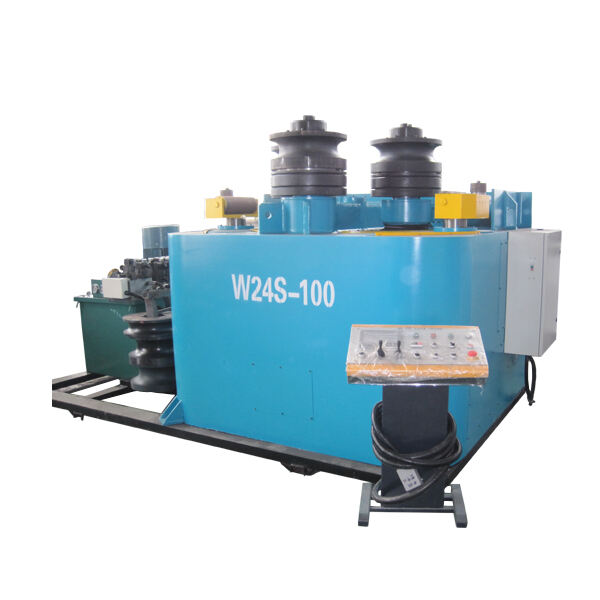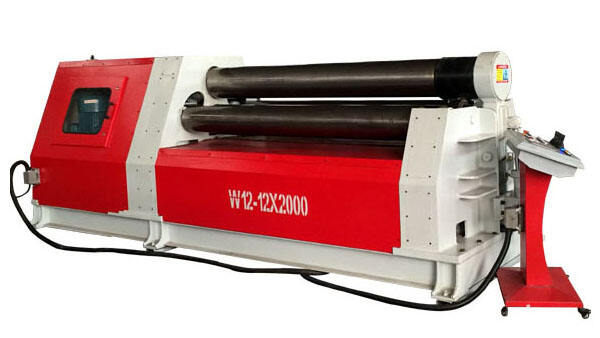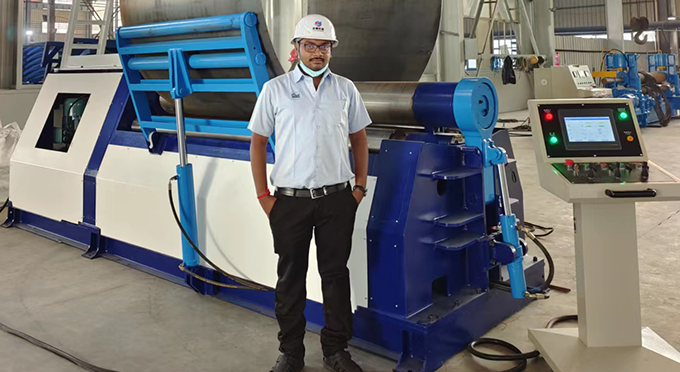Advanced CNC-Controlled Systems for Precision and Repeatability
Integration of CNC controls in plate bending machines for consistent, high-precision forming
Today's plate bending machines hit bending accuracies around ±0.1 degrees thanks to those CNC controlled axis systems, way better than what manual operators can manage. The big plus here is no more inconsistency problems that come from different workers doing things their own way. This matters a lot for industries like aerospace and energy where even tiny mistakes matter. We're talking about structural failures if there's just half a degree off somewhere. Some of these newer machines actually tweak the roll positions nearly 200 times every second while shaping metal. They handle everything from thin 6mm aluminum sheets all the way up to thick 120mm steel plates according to Pinnacle Metal's latest report from 2024.
Digital monitoring, sensors, and real-time feedback for automated control
Laser scanners paired with strain gauges can measure material thickness down to the micron level, which helps machines automatically adjust for when materials bounce back after being bent. We saw this in action during an offshore wind tower construction last year where workers spent 70 percent less time on those tedious post-bend calibrations. The roundness of the towers also improved significantly, hitting better tolerances by around 32%. These systems use machine learning to process information from thousands of bending operations now tracking over 15,000 cycles. The result? Roll pressure predictions are about 8% more accurate compared to what we used to get with traditional approaches, making production smoother and saving both time and money in the long run.
Smart automation: IoT, AI, and machine learning in modern plate rolling systems
AI-driven convolutional neural networks analyze real-time thermal imaging to detect and prevent stress hotspots during bending. One manufacturer reported a 25% reduction in scrapped components after implementing IoT-enabled predictive maintenance. These intelligent systems automatically adapt parameters when switching between materials, cutting setup times by 40% compared to manual CNC programming.
Transition from manual to self-optimizing plate bending machines
Closed-loop control systems now ensure 99.4% repeatability over 500 consecutive bends—a level unattainable with manual operations. Adaptive algorithms optimize toolpaths 12% faster than human programmers while reducing energy consumption by 18%. This evolution supports 24/7 unmanned production of complex geometries, such as conical wind tower sections, with dimensional variance under 1mm.
Specialized Plate Bending Solutions for Wind Energy Infrastructure
Challenges in bending thick plates for wind tower shells and offshore foundations
Wind tower construction demands bending steel plates up to 150mm thick with dimensional tolerances below 1.5mm (ASME 2023), complicated by material springback and asymmetric loading in offshore environments. Unlike standard applications, wind energy systems must maintain ±0.8° angular precision in conical segments while compensating for variable coastal weather conditions.
Four-roll CNC plate bending machines for high-precision wind tower segments
Four-roll CNC systems with 360-ton capacity are engineered specifically for wind tower arcs. Through synchronized hydraulic compression and position-controlled top rolls, these machines achieve 99.4% repeatability on 80m-long tower sections. Operators report 67% fewer manual adjustments compared to three-roll systems when forming S355 steel used in nacelle platforms.
Case study: Rolling machines in offshore wind foundation production
A recent offshore wind manufacturing analysis found that four-roll plate bending systems reduced monopile production errors by 42% in North Sea projects. Real-time thickness monitoring and adaptive CNC programs effectively compensated for inconsistent yield strengths in Grade DH36 steel across 12m-diameter foundation rings.
Customization for renewable energy pressure vessels and tank heads
Beyond structural components, modern plate benders are adapted for curved solar receiver panels and biofuel tank domes. Dual-mode operation enables rapid transitions between wind tower arcs (12–25m radii) and compact pressure vessel heads (1.8–4m radii) without tooling changes—essential for manufacturers serving multiple renewable sectors.
High-Tolerance Bending for Oil & Gas and Aerospace Applications
Precision Plate Bending for Oil & Gas Pipelines with 99.6% Dimensional Accuracy
The latest plate bending tech can hit around 99.6% accuracy when shaping those curved pipeline sections according to Industry Analysis 2024 findings. This level of precision really helps cut down on those pesky weld gaps and stress points that plague high pressure systems. And let's not forget the bottom line benefits either these systems are credited with reducing joint failures by somewhere between 10 to 15 percent across the board. Most modern setups combine hydraulic pre-bending techniques with smart AI algorithms that account for material springback during forming. These advanced methods make sure everything meets the tough requirements set out in ASME B16.49 standards specifically designed for pipelines handling sour service conditions.
Hydraulic and Electronic Roller Synchronization for Uniform Deformation
Twin-cylinder hydraulic systems maintain ±0.05 mm roller alignment during heavy-plate bending, while electronic servo adjustments counteract deflection in materials exceeding 100 mm thickness. Real-time load monitoring prevents under- or over-bending in duplex stainless steel pipelines, crucial for subsea applications requiring wall thickness tolerances within ±1.2 mm.
Aerospace-Grade Requirements: Strength, Precision, and Cleanroom-Compatible Servo-Electric Systems
Aerospace bending requires ISO Class 5 cleanroom compatibility and micro-crack prevention in titanium alloys. Servo-electric systems with 0.001° angular resolution dominate wing spar forming, eliminating risks of hydraulic fluid contamination. Research shows these systems reduce post-forming surface treatment time by 40% compared to traditional hydraulic alternatives.
Custom Solutions for High-Strength Alloys and Thick-Plate Aerospace Components
Four roll setups handle processing of Inconel 718 and Ti-6Al-4V materials that can be as thick as 150 millimeters. The rollers are heated between about 150 to 300 degrees Celsius which helps stop work hardening issues when making parts for rocket engines. For satellite fuel tank production, there's adaptive tooling that makes it possible to switch between radius sizes ranging from 12 to 60 meters all within one pass operation. This technology achieves pretty impressive results too - around 0.25 mm per meter straightness on those special cryogenic grade aluminum lithium panels that need to be curved.
Mechanical Innovations for Complex Geometries and Demanding Tasks
Modern plate bending machines feature re-engineered mechanical structures with reinforced frames and high-torque gear systems, delivering 25% higher bending forces (ASME 2024) while maintaining positioning accuracy within ±0.1 mm. These enhancements support processing of 200 mm-thick steel plates in shipbuilding and other heavy-industry applications.
4-Roll and Cone-Specific Designs for Conical Transitions
Advanced four-roll systems use synchronized servo drives to manage conical transitions with up to an 8:1 diameter ratio. Dynamic tilt adjustment of the upper roll compensates for uneven material flow during asymmetrical bending cycles.
Integrated Cone Rolling and Post-Weld Calibration
Hybrid systems combine cone rolling with in-line laser scanning, using AI-driven recalibration to correct weld-induced distortions. This integration cuts post-processing time by 40% compared to traditional workflows.
Specialized Tooling for Variable Curvatures
Quick-change tooling stations support:
- Multi-radius dies for parabolic tank sections
- Variable geometry clamps for spiral staircases
- Adaptive mandrels for elliptical ductwork
These innovations meet rising demand for complex shapes in architectural metalwork and industrial machinery, supporting energy efficiency through minimized material waste.
FAQ Section
What is the accuracy level of modern plate bending machines?
Modern plate bending machines using CNC-controlled systems can achieve accuracies of around ±0.1 degrees, which is significantly more precise than what can be achieved manually.
How do CNC machines adapt to different materials during bending processes?
CNC systems utilize sensors, real-time feedback, and AI to automatically adjust parameters when switching between different materials, ensuring optimal bending accuracy and reducing setup time.
What industries benefit the most from advanced CNC-controlled plate bending?
Industries such as aerospace, wind energy, oil & gas, and heavy manufacturing benefit greatly due to the high precision and repeatability, reducing the risk of structural issues and improving production efficiency.
How do modern systems handle thick plate bending for wind tower construction?
Four-roll CNC machines are specifically designed for the demanding specifications of wind tower arcs, achieving high repeatability with fewer manual adjustments.
What innovations support bending in complex geometries?
Re-engineered mechanical structures and advanced toolings such as multi-radius dies, variable geometry clamps, and adaptive mandrels support complex shapes and maintain energy efficiency with minimal material waste.
Table of Contents
-
Advanced CNC-Controlled Systems for Precision and Repeatability
- Integration of CNC controls in plate bending machines for consistent, high-precision forming
- Digital monitoring, sensors, and real-time feedback for automated control
- Smart automation: IoT, AI, and machine learning in modern plate rolling systems
- Transition from manual to self-optimizing plate bending machines
- Specialized Plate Bending Solutions for Wind Energy Infrastructure
-
High-Tolerance Bending for Oil & Gas and Aerospace Applications
- Precision Plate Bending for Oil & Gas Pipelines with 99.6% Dimensional Accuracy
- Hydraulic and Electronic Roller Synchronization for Uniform Deformation
- Aerospace-Grade Requirements: Strength, Precision, and Cleanroom-Compatible Servo-Electric Systems
- Custom Solutions for High-Strength Alloys and Thick-Plate Aerospace Components
- Mechanical Innovations for Complex Geometries and Demanding Tasks
-
FAQ Section
- What is the accuracy level of modern plate bending machines?
- How do CNC machines adapt to different materials during bending processes?
- What industries benefit the most from advanced CNC-controlled plate bending?
- How do modern systems handle thick plate bending for wind tower construction?
- What innovations support bending in complex geometries?




